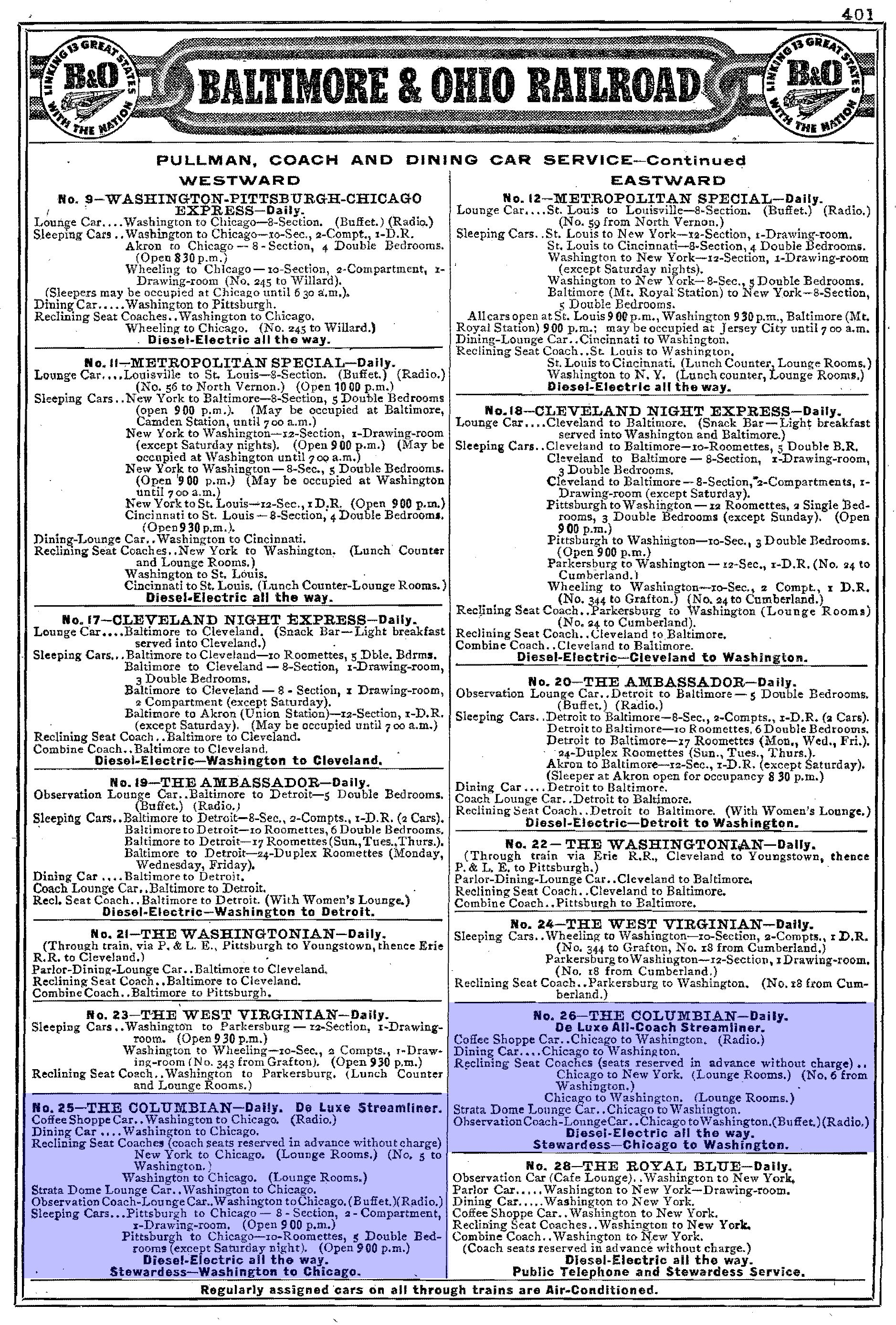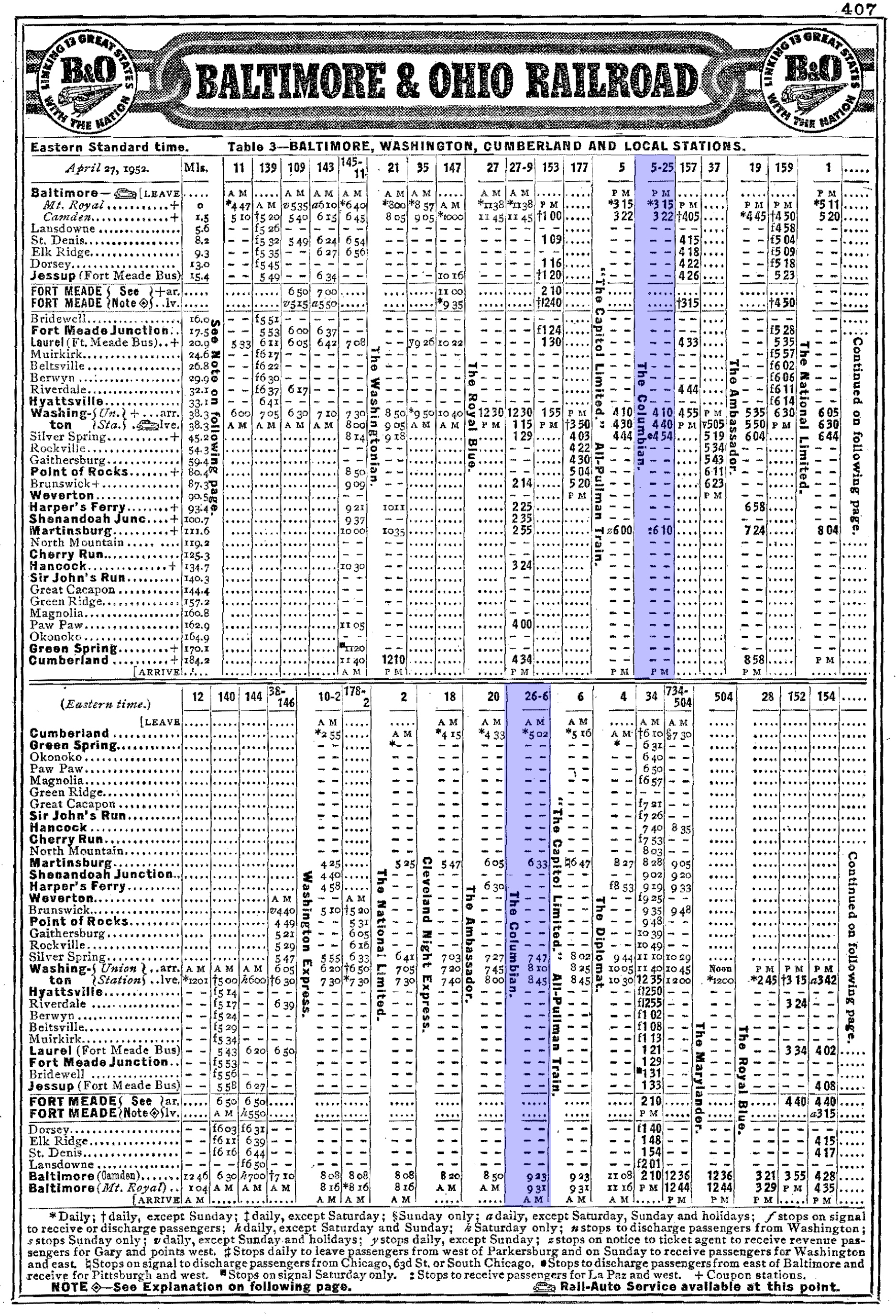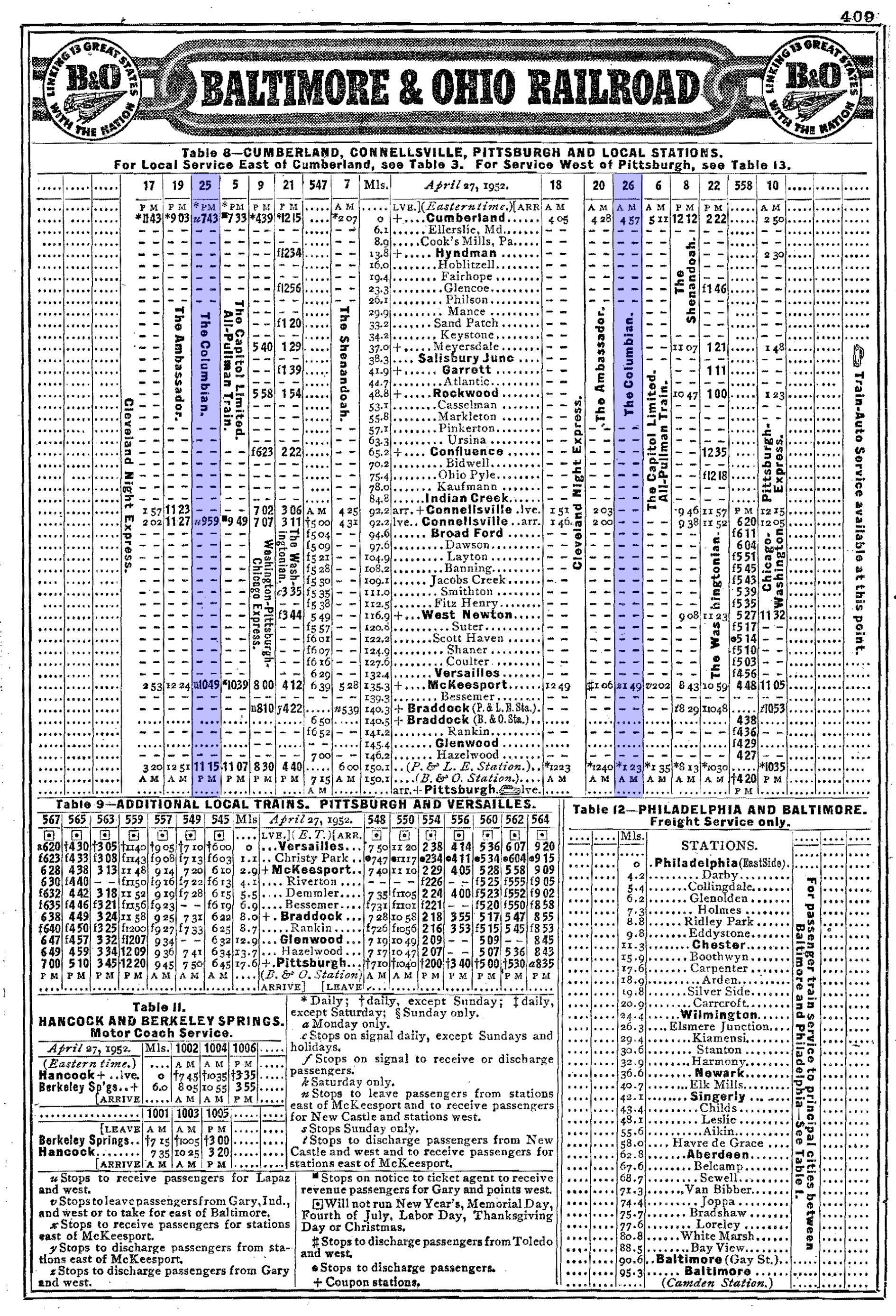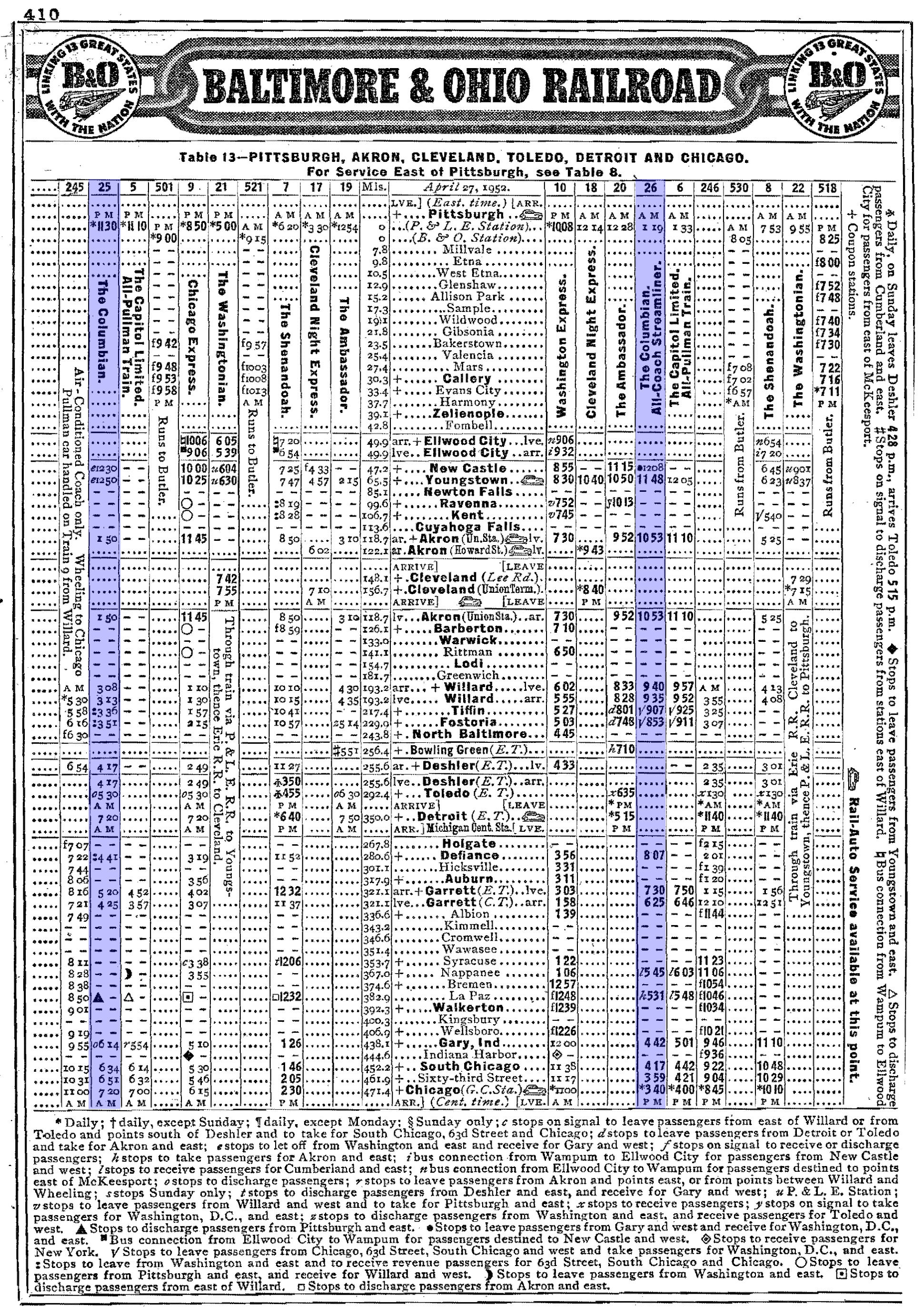B&O's "Columbian" (Train): Route, Consist, Timetable
Last revised: February 25, 2025
By: Adam Burns
The Columbian was a named passenger train operated by the Baltimore & Ohio running between Jersey City, New Jersey and Chicago. It was initially launched in 1931 as a heavyweight coach train, which operated as a companion service to the railroad's regional Royal Blue, which served the New York-Baltimore market.
During the streamliner race with the PRR, the B&O reequipped the Columbian in 1949 and extended the train to Chicago. The premier coach-only train was known for its scenic route through the Allegheny Mountains, first-class accommdations, and legendary B&O service.
During its early years the train proved exceptionally successful for the B&O and was regularly sold out. As patronage declined during the 1950s, the Columbian was combined with the two other trains, notably the Capitol Limited. Finally, during the mid-1960s the railroad dropped the name altogether.
Photos
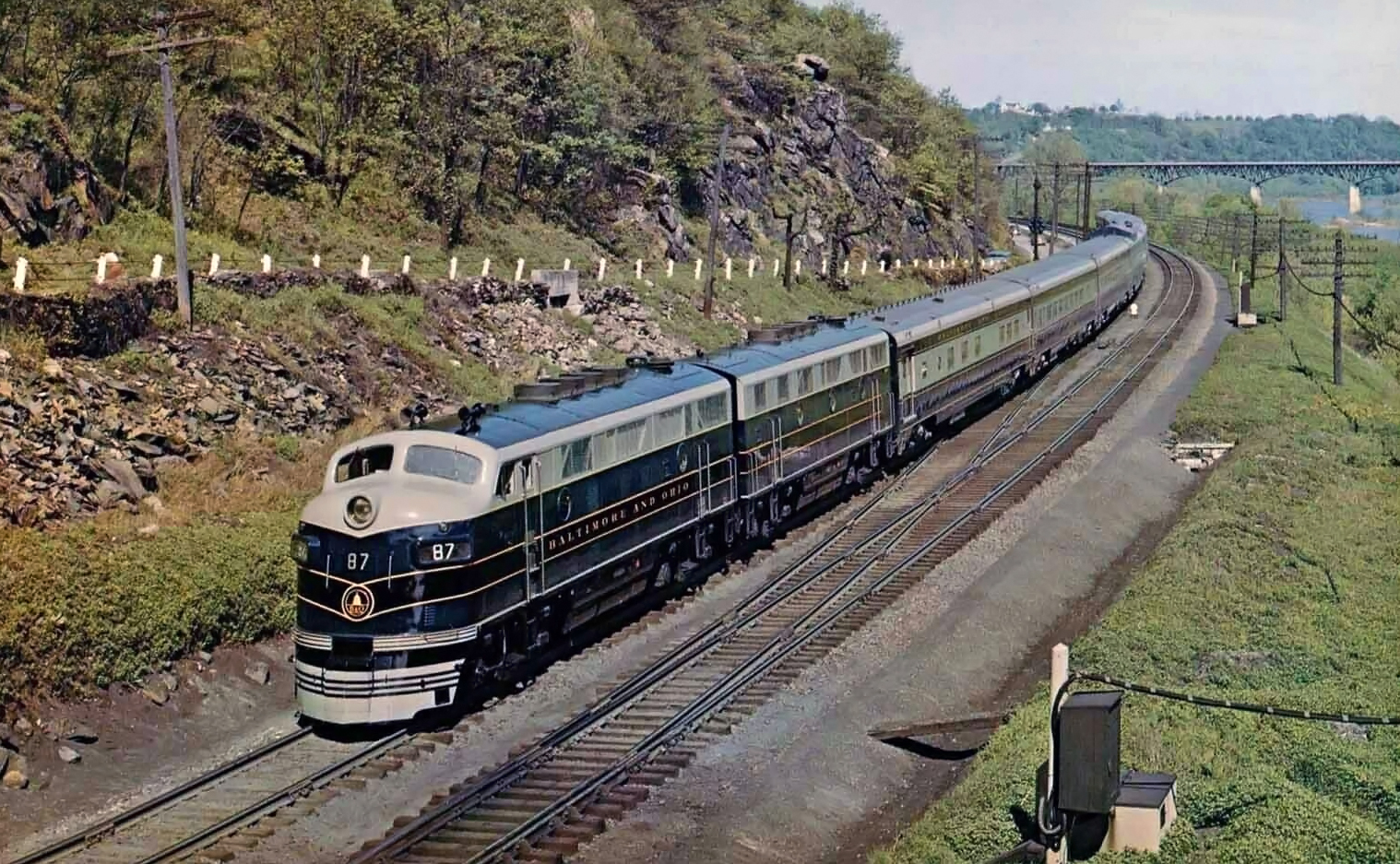 The Baltimore & Ohio took a tremendous amount of photos publicizing its new "Columbian" trainset. It is seen here posed westbound along the main line skirting the Potomac River a few miles east of Harpers Ferry in the spring of 1949. The train's consist included coffee-shoppe car "Harpers Ferry," coaches "McKeesport" and "Gary," coach-lounge Strata-Dome "High Dome," a diner, two more coaches, and finally the coach-lounge-observation "Chicago." The B&O touted this service as an all-coach consist although it also included a 8 section/4 double-bedroom sleeper between Chicago and Pittsburgh. American-Rails.com collection.
The Baltimore & Ohio took a tremendous amount of photos publicizing its new "Columbian" trainset. It is seen here posed westbound along the main line skirting the Potomac River a few miles east of Harpers Ferry in the spring of 1949. The train's consist included coffee-shoppe car "Harpers Ferry," coaches "McKeesport" and "Gary," coach-lounge Strata-Dome "High Dome," a diner, two more coaches, and finally the coach-lounge-observation "Chicago." The B&O touted this service as an all-coach consist although it also included a 8 section/4 double-bedroom sleeper between Chicago and Pittsburgh. American-Rails.com collection.History
Despite its underdog, third place status the Baltimore & Ohio fielded an impressive fleet of streamliners, which provided guests with the very best of service.
One of these was the Columbian, which began serving the New York-Washington market in the 1930s. It was no secret the PRR commanded the upperhand on this corridor. It maintained a fast, electrified, multi-track main line while the B&O needed help to just reach Jersey City north of Philadelphia via the Reading and Jersey Central.
It also did not have direct access to downtown Manhattan. Like many roads, it maintained ferry service across the Hudson River via CNJ's terminal in Jersey City, New Jersey.
Nevertheless, the B&O was a fighter and inaugurated the Royal Blue on July 31, 1890. It was once canceled during World War I but soon relaunched during the early 1920s.
Early Streamliners
When the streamliner era took off in 1934, the B&O wasted no time launching its own. On April 25, 1937 it rechristened the Royal Blue with lightweight, aluminum cars led by a shrouded, bullet-nose 4-6-2 Pacific, #5304. This variant of the P-7 class was soon replaced with new streamlined EA diesels from Electro-Motive.
Despite the railroad's inferior route, the Royal Blue's new look - coupled with its first-class services - immediately provided the B&O with an advantage over its arch rival as the Pennsy had yet to inaugurate such a train.
To complement the revamped Royal Blue the B&O relaunched its companion train during December of 1937; known as the Columbian the train's consist was an all-coach affair using rebuilt, modernized streamlined heavyweight cars powered by the new EAs.
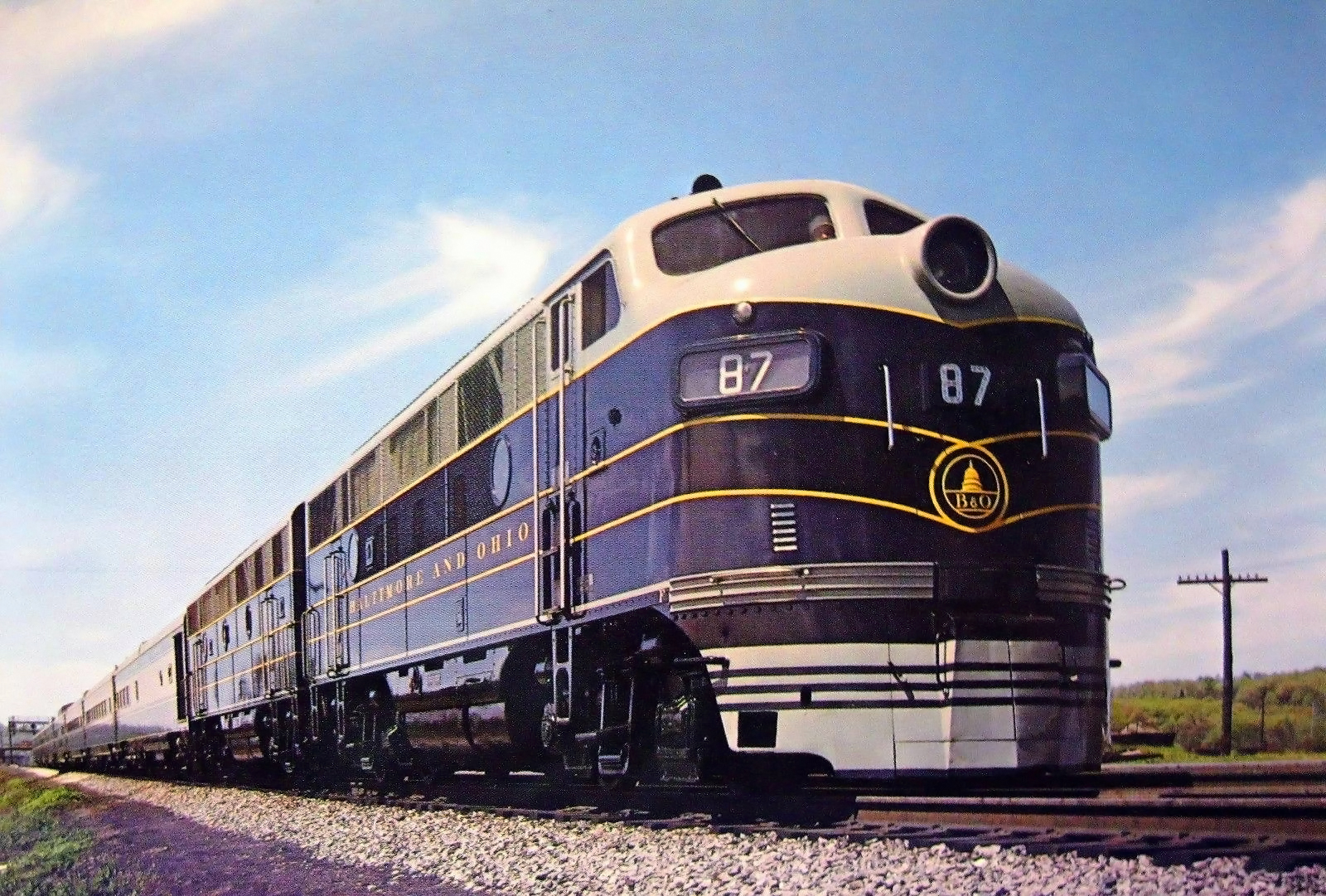 Another Baltimore & Ohio publicity photo of the newly reequipped, "Columbian" (Chicago - Washington/Baltimore - New York) heading eastbound on the Cumberland Division/East End in April of 1949 just before it entered service. The train's consist seen here included the Coffee-Shoppe "Harpers Ferry," a pair of reclining seat coaches ("McKeesport" and "Gary"), the all-new Strata-Dome lounge "High Dome" (first domes in the East), two additional coaches, a diner, and the observation-buffet-lounge "Chicago." A high-class affair for what was largely a coach-only train!
Another Baltimore & Ohio publicity photo of the newly reequipped, "Columbian" (Chicago - Washington/Baltimore - New York) heading eastbound on the Cumberland Division/East End in April of 1949 just before it entered service. The train's consist seen here included the Coffee-Shoppe "Harpers Ferry," a pair of reclining seat coaches ("McKeesport" and "Gary"), the all-new Strata-Dome lounge "High Dome" (first domes in the East), two additional coaches, a diner, and the observation-buffet-lounge "Chicago." A high-class affair for what was largely a coach-only train!In truth, the Columbian was not new; the B&O had first launched the service on May 24, 1931 (#25 westbound and #26 eastbound) with heavyweight equipment and advertised as the first air-conditioned train in the nation.
As one of the early streamliner propoents, the B&O was also noteworthy for inaugurated diesel-powered trains. The aforementioned EAs/EBs also powered the Capitol Limited, National Limited, Royal Blue, and Columbian. According to one of the B&O's marketing campaigns:
"When you ticket passengers to and from New York via the Baltimore & Ohio they have the advantage of 17 station stops in Great New York.
Upon arriving in Jersey City, they step from the train into comfortable, streamlined motor coaches that take passengers and their hand baggage right from the trainside to any of 17 places in New York and Brooklyn, including a number of leading hotels.
Consist (1952)
No bother with hand baggage. Checked on the train it is delivered to passengers when they leave the coach. No traffic worries, no taxicab expense, no tips, no long walks - and there's no extra charge.
Leaving New York, there is available the same convenient service. Baltimore & Ohio fast, frequent, air-conditioned trains to and from New York including the Shenandoah and Fort Pitt Limited, to and from Pittsburgh and Chicago, and the National Limited and the Diplomat to and from Cincinnati, Louisville, and St. Louis. Also, the streamlined Royal Blue and Columbian between Washington, Baltimore, Philadelphia, and New York, featuring new ideas in streamlined trains."
Not to be outdone, the Pennsy soon streamlined its all-coach, New York-Chicago Trail Blazer. In an effort to keep up, the B&O matched its competitor by lengthening the route of the Columbian, sending it to Chicago as a companion service of the Capitol Limited.
Timetable (1952)
The train was re-inaugurated in December of 1941 with this new schedule and rebuilt equipment. It enjoyed strong patronage throughout the war years and as Joe Welsh notes in his book, "Baltimore & Ohio's Capitol Limited And National Limited," the train ran full throughout this time.
During 1945 the B&O reequipped the train with streamlined E7s and during December of that year placed an order with Pullman-Standard for two brand new coach trainsets. When these arrived in the spring of 1949 the railroad wasted no time marketing its upgraded service, taking a series of publicity photos showcasing the train.
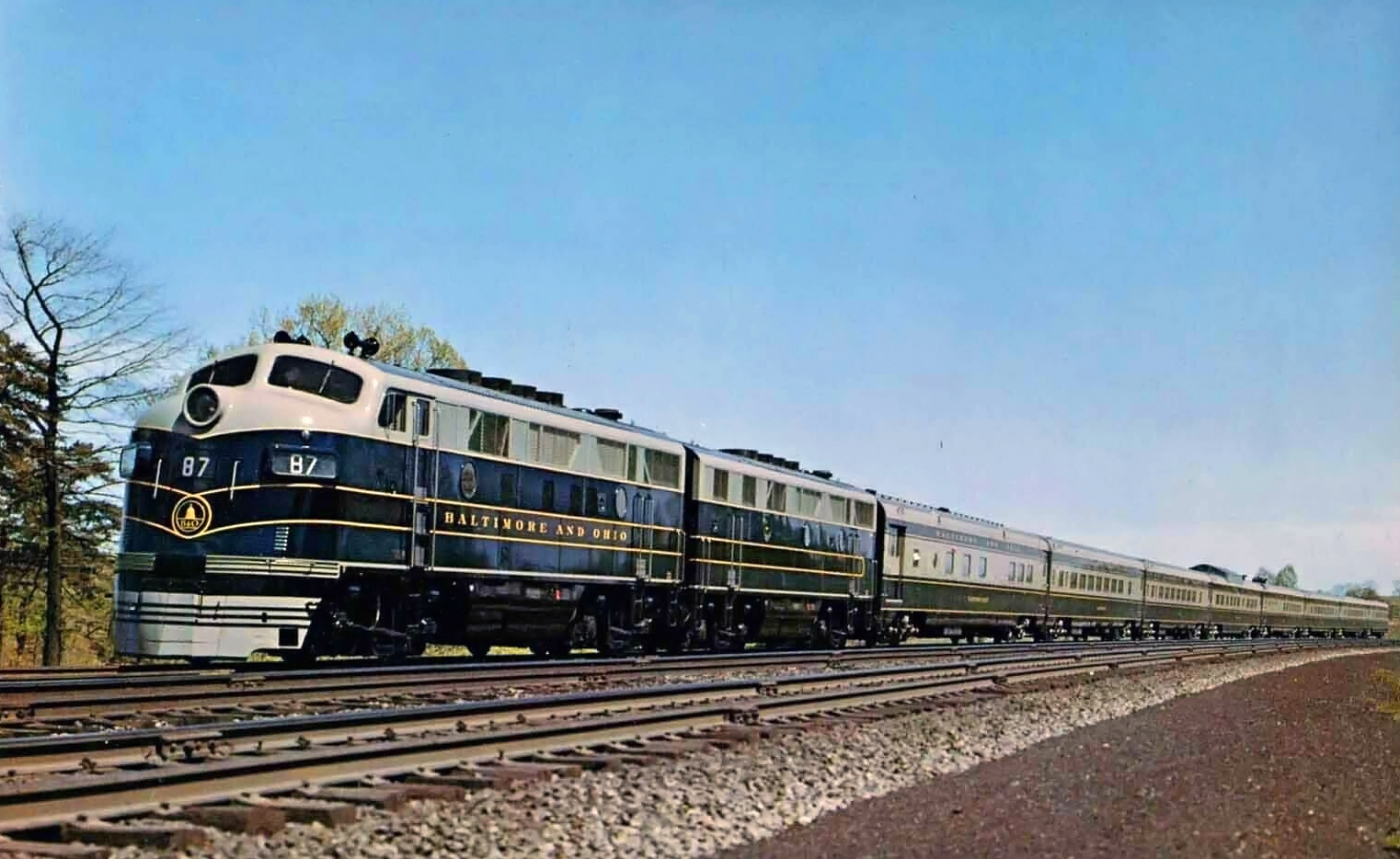 Another of the many publicity photos the Baltimore & Ohio captured of its new, all-coach service, the "Columbian," in the spring of 1949. Note the Strata-Dome (built by Pullman-Standard) mid-train. This scene depicts the train posed westbound east of Cumberland, Maryland.
Another of the many publicity photos the Baltimore & Ohio captured of its new, all-coach service, the "Columbian," in the spring of 1949. Note the Strata-Dome (built by Pullman-Standard) mid-train. This scene depicts the train posed westbound east of Cumberland, Maryland.This new equipment would be the train's pinnacle as its sported such amenities as a buffet, tavern lounge bar/observation, and Strata-Domes that offered unparalleled vistas.
The Columbian was an eight-car consist in all and used brand new F3A/Bs for power, #87A-88A and #87x-88x (Bs). Adorned in the railroad's regal royal blue and grey with gold pinstripes it was a very elegant train.
Timetable (July, 1938)
| Time/Leave (Train #25) | Milepost | Location | Time/Arrive (Train #26) |
|---|---|---|---|
| 4:38 PM (Dp) | 0.0 | 2:42 PM (Ar) | |
| 4:50 PM (Dp) | 1.0 | 2:30 PM (Ar) | |
| 5:05 PM | 12.5 | 2:14 PM | |
| 5:18 PM | 24.0 | 2:01 PM | |
| 6:15 PM | 84.1 | 1:05 PM | |
| 6:31 PM | 91.9 | 12:50 PM | |
| 6:58 PM | 116.9 | 12:22 PM | |
| 8:05 PM | 186.3 | 11:14 AM | |
| 8:10 PM | 187.8 | 11:08 AM | |
| 8:50 PM | 224.6 | 10:30 AM |
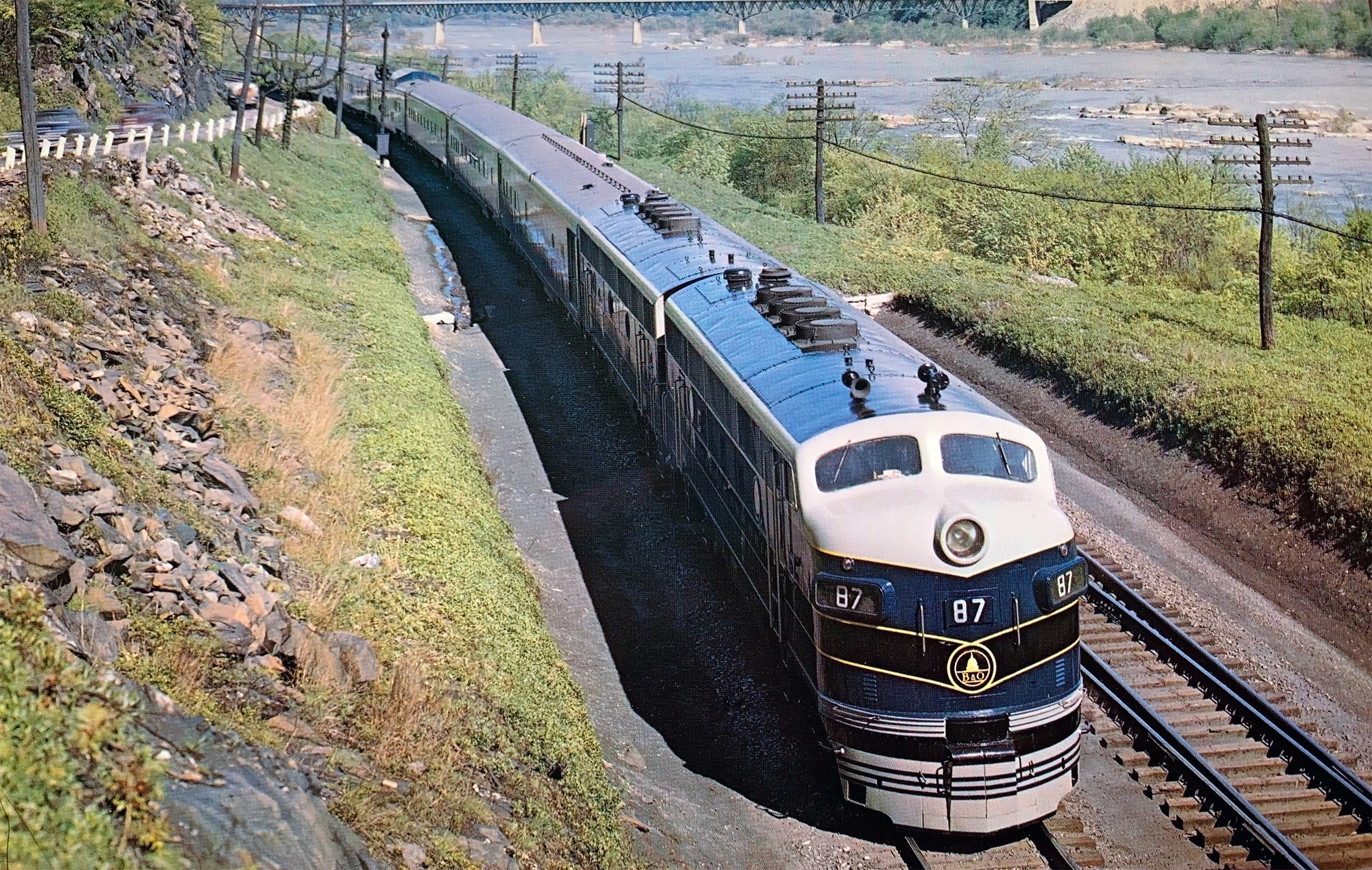 In this publicity photo of the very same "Columbian" consist featured at the top of this article, the train has been photographed from a slightly different angle. Author's collection.
In this publicity photo of the very same "Columbian" consist featured at the top of this article, the train has been photographed from a slightly different angle. Author's collection.Final Years
Unfortunately, the train's decline began almost immediately postwar and continued through the 1950s. By 1952, the Columbian was cutback to Washington, D.C., discontinuing service direct to New York. Shortly thereafter the B&O combined the train with the Ambassador between Washington, D.C. and Willard, Ohio in January of 1954.
During April of 1958 the Royal Blue was canceled as the B&O ceded defeat to the Pennsy in this market entirely. A year later, in 1959, the Columbian was permanently combined with the flagship Capitol Limited, which spelled the train's end.
By then, the B&O was already in serious financial trouble and attempting to cut costs wherever possible. Further cutbacks continued as in October of 1961 the Capitol Limited, Columbian, and Ambassador were all combined as one train east of Willard.
Finally, it was all over after April 26, 1964 when the B&O quietly eliminated the Columbian name from its timetable ending a train that had been in service for more than 30 years.
Sources
- Johnston, Bob and Welsh, Joe. Art Of The Streamliner, The. New York: Andover Junction Publications, 2001.
- Reynolds, Kirk and Oroszi, David. Baltimore & Ohio Railroad. Osceola: MBI Publishing, 2000.
- Schafer, Mike and Welsh, Joe. Streamliners, History of a Railroad Icon. St. Paul: MBI Publishing, 2003.
- Welsh, Joe. Baltimore & Ohio's Capitol Limited And National Limited. St. Paul: MBI Publishing, 2007.

